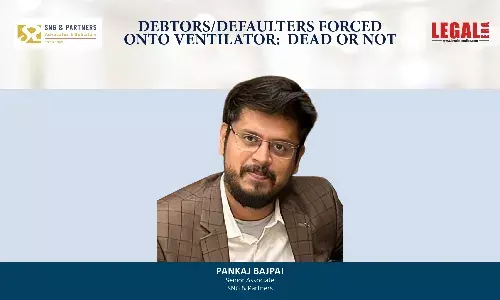The National Company Law Tribunal Has Jurisdiction To Direct The Enforcement Directorate To Release Attached Properties Of The Corporate Debtor

The National Company Law Tribunal Has Jurisdiction To Direct The Enforcement Directorate To Release Attached Properties Of The Corporate Debtor INTRODUCTION: The Bombay High Court in its decision in Mr. Shiv Charan and Anr. Vs. Adjudicating Authority and Anr. and connected Petition1 held that the NCLT has the jurisdiction to direct the Enforcement Directorate (ED) to release...
The National Company Law Tribunal Has Jurisdiction To Direct The Enforcement Directorate To Release Attached Properties Of The Corporate Debtor
INTRODUCTION:
The Bombay High Court in its decision in Mr. Shiv Charan and Anr. Vs. Adjudicating Authority and Anr. and connected Petition1 held that the NCLT has the jurisdiction to direct the Enforcement Directorate (ED) to release attached properties of a corporate debtor once the resolution plan has been approved and immunity from prosecution is triggered under Section 32A of the Insolvency and Bankruptcy Code, 2016.
FACTS:
The Petitioners are the Resolution Applicants and the Directorate of Enforcement (“ED”) is the Respondent in Writ Petition (L) No.9943 of 2023 (“WP 9943”) and in Writ Petition (L) No.29111 of 2023 (“WP 29111”), respectively arising out of resolution proceedings of DSK Southern Projects Pvt. Ltd. (“Corporate Debtor”), under the Corporate Insolvency Resolution Process (“CIRP”) since 9th December, 2021.
By an order dated 17th February, 2023 (“Approval Order”) passed under Section 31 of the Insolvency and Bankruptcy Code, 2016 (“IBC”) a Resolution Plan propounded by the Resolution Applicants came to be approved by the Learned National Company Law Tribunal, Mumbai (“NCLT”).
Nearly four years prior to commencement of the CIRP various First Information Reports (“FIRs”) were filed against the Corporate Debtor and the erstwhile promoters alleging "scheduled offences" under the Prevention of Money Laundering Act, 2002 ("PMLA, 2002") and an Enforcement Case Information Report (“ECIR”) also came to be filed by the ED. Subsequently, upon filing a complaint by the ED, four bank accounts of the Corporate Debtor and 14 flats constructed by the Corporate Debtor were attached (“Attached Properties”) by a confirmatory order dated 5th August, 2019 passed by the Adjudicating Authority under Section 8 of the PMLA, 2002.
The above attachment continued even after the commencement of the CIRP and further continued even after the approval of the Resolution Plan passed under the Approval Order.
The Resolution Professional filed an Interim Application being IA/383/2022 (“IA 383”) in the CIRP proceedings seeking directions against the ED to release the Attached Properties. The NCLT while disposing of the IA 383 by its order dated 28th April, 2023 held that once the moratorium is commenced, the attachment must abate and that in view of the final approval contained in the Approval Order, the Attached Properties must be released by reason of Section 32A of the IBC.
Section 32A of the IBC provides for immunity to corporate debtors and their assets, upon approval of a resolution plan, subject to certain conditions stipulated in that provision.
On 10th April, 2023, WP 9943 was filed by the Resolution Applicants against the Adjudicating Authority under the PMLA, 2002 arraying the ED as the Respondent No. 1 and the Deputy Director, ED, as Respondent No. 2.
The WP 9943 was filed to quash the ECIR, the original complaint by which the assets of the Corporate Debtor were attached and direct the Respondents to release the assets of the Corporate Debtor so attached in view of Section 32A of the IBC.
Thereafter, WP 29111 was filed by the ED on 17th October, 2023 challenging the authority and legal capacity of the NCLT to pass orders invoking Section 32A of the IBC and prayed for quashing of the NCLT’s order dated 28th April, 2023 passed in IA 383 directing the ED to release Attached Properties.
ISSUE FOR CONSIDERATION:
The issue for consideration before the Bombay High Court was as follows:
Whether the NCLT had the jurisdiction to direct the ED to release the Attached Properties by invoking Section 32A of IBC?
SUBMISSIONS ON BEHALF OF THE PETITIONERS:
It was submitted by the Petitioners that Section 32A of the IBC being a non obstante clause would override the provisions of PMLA, 2002 should a conflict between them arise.
The Petitioners submitted that the jurisdiction of Section 32A is attracted only after a resolution plan is approved under Section 31 of the IBC.
It was further submitted that in case of conflict between the statutory moratorium triggered by Section 14 of the IBC and the powers of attachment under PMLA 2002, the interpretation of Section 32A would have no relevance because the jurisdiction of Section 32A commences when the moratorium under Section 14 of the IBC ends.
It was further submitted that the condition to be fulfilled for the immunity to be available to the Corporate Debtor under Section 32A of the IBC, was that there should be a change in management and control of the Corporate Debtor in favor of persons unconnected with those in management and control of the Corporate Debtor when the alleged offense took place.
It was also submitted that Section 32A discharges only the Corporate Debtor and its assets, taking care to enable attachments and proceedings to continue against other accused with the same charges.
It was further submitted that the interim measure of attachment under the PMLA, 2002 must come to an end upon approval of a resolution plan as per Section 32A of the IBC.
SUBMISSIONS ON BEHALF OF THE RESPONDENTS:
It was submitted that Resolution Applicants are treating the Bombay High Court, being a Writ Court as an Execution Court to execute an order of the NCLT, the statutory remedy for which, would lie under Section 424(3) of the Companies Act, 2013 and Rule 56 and 57 of the NCLT Rules, 2016 that empowers the Tribunal or the Appellate Tribunal to enforce any order made by it.
It was submitted that the Attached Properties were attached by the ED provisionally and then finally confirmed before commencement of the CIRP i.e., before the moratorium under the IBC was commenced.
It was further submitted that any person aggrieved by such attachment had a statutory right to appeal under Section 26(1) of the PMLA, 2002 and approach the designated Appellate Tribunal or where an attachment eventually leads to confiscation under Section 8(5) of the PMLA, 2002, the aggrieved person is entitled to apply to the Special Court under Section 8(8) of the PMLA, 2002 seeking a direction to the Government to restore the confiscated property.
It was further submitted that Section 32A of the IBC should not be read in a manner that would override the provisions of PMLA, 2002 as it would defy the special objectives of enacting the PMLA, 2002.
It was further submitted that the jurisdiction of NCLT under Section 60 (5) of the IBC should be restricted to interpretation of IBC provisions alone.
It was further submitted that in case where interpretation of IBC provisions would intrude the PMLA’s powers of attachment of properties, care should be taken to ensure that the power of the ED to attach assets is not sought to be trampled upon even before a resolution plan is approved.
It was also submitted that effect of Section 32A of the IBC should not curtail the powers of ED to keep the properties attached under the PMLA, 2002 after the CIRP starts and before the Resolution Plan is approved.
JUDGMENT:
The Hon’ble Supreme Court in Manish Kumar Vs Union of India2, ruled that the immunity under Section 32A is a conscious and valid legislative conferment by Parliament. In doing so, the Hon’ble Supreme Court had the benefit of the Union of India’s clear explanation and support for the view that corporate debtors must get to begin with a clean slate under Section 32A of the IBC, making a clean break from their past.
In view of the aforesaid, the Hon’ble Bombay High Court observed that, when a resolution plan with the ingredients that qualify for immunity under Section 32A comes to be approved, quasi-judicial authorities including the Adjudicating Authority under the PMLA, 2002 must take judicial notice of the development and release their attachment on their own. This is the only means of ensuring that the rule of law as stipulated in Section 32A of the IBC runs its course.
The Hon’ble Bombay High Court further observed that the NCLT was accurate in the valid exercise of its explicit jurisdiction in declaring under both, the Approval Order (dated 17th February, 2023) under Section 31 of the IBC and in the April 2023 Order (under Section 60 (5) of the IBC), that the corporate debtor would stand discharged from the offences committed prior to the commencement of CIRP and the Attached Properties would become free from the time the resolution plan came to be approved as per benefit under Section 32A of the IBC.
It was further held that the jurisdiction under Section 32A would be attracted from the point when the resolution plan under section 31 of the IBC is approved. It was observed that the immunity accorded under Section 32A is subject to the condition that there is clean break with a change in ownership of, and control over, the corporate debtor.
It was further held that there is no scope whatsoever for the attachment effected by the ED over the Attached Properties to continue once the Approval Order came to be passed. It is Section 32A of the IBC, on which the NCLT based its declaration that the Attached Properties must be released, and that is entirely correct.
It was also observed that Section 60(5) of the IBC clearly empowers the NCLT to answer the question of whether the statutory immunity under Section 32A has accrued to a corporate debtor. As a consequence, the NCLT is well within its jurisdiction and power to rule that prior attachment of the property of a corporate debtor that is subject matter of an approved resolution plan, must be released, if the jurisdictional facts for purposes of Section 32A exist.
Both Section 32A and Section 60(5) of the IBC being non-obstante provisions, they would prevail, with no room for concern, real or imagined, about any conflict between legislations. Therefore, it was held that the interpretation by the NCLT in both, the Approval Order, and the NCLT’s order dated 28th April, 2023 directing the ED to release Attached Properties, did not at all render nugatory, the provisions of the PMLA, 2002 or its legislative objectives. The NCLT had merely given effect to the provisions of Section 32A of the IBC in its terms and that is an accurate decision.
It was therefore held that the NCLT by powers vested in it by Section 60 (5) of the IBC had rightly discharged the Corporate Debtor from the offences alleged to have been committed prior to the CIRP and declaring that the Attached Properties as identified in the Approval Order became free of attachment from the time of approval of the resolution plan eligible for benefit of Section 32A.
In view of the above, it was observed that the NCLT in its capacity as the Adjudicating Authority under the IBC has only interpreted the provisions of Section 32A and applied them to the facts at hand, to declare that the attachment of the Attached Properties by the ED must come to an end.
In view of the aforesaid, the Hon’ble Bombay High Court while upholding the NCLT’s order, directed the ED to release the properties of the Corporate Debtor that were attached under the Prevention of Money Laundering Act, 2002 (PMLA).
The content of this article is intended to provide a general guide to the subject matter. Specialist advice should be sought about your specific circumstances.
2. (2021) 5 SCC






